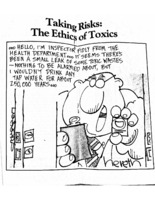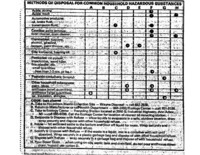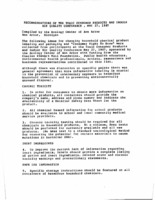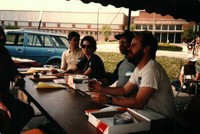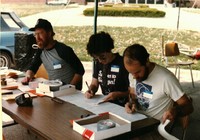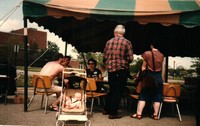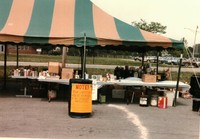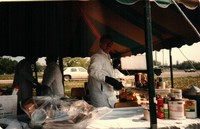Household Toxics Awareness
"There is much we can do on a local level, working with state and federal agencies, to prevent contamination of our water through careless handling of toxics. This starts at home by using toxic products carefully, being aware of the consequences of improper disposal, and choosing less toxic products when possible.” - Nancy Stone, Ecology Report, Vol. 16, No. 10, December 1984.
Love Canal's Toxic Legacy
During the 1980s, the Ecology Center joined nationwide efforts advocating for the right to know about toxics and the hazardous impact of chemicals found in household cleaning agents and products. Within the U.S., concern about chemical exposure in residential contexts had been heightened by official recognition in 1976 of widespread negative health effects experienced by residents of Love Canal, NY. As a consequence of seepage from chemicals previously dumped in an abandoned waterway, many basements in Love Canal exposed inhabitants to toxins through contact with the air and soil. In Michigan, the public outcry encouraged more attention both to toxic chemical dumping and waste disposal at local levels.
As state-wide legislation was still being developed throughout much of the decade, the Ecology Center acted to bring information about toxic chemicals and best-practices of residential hazardous waste disposal to the public. The EC's awareness campaign had three major initiatives: household toxics workshops and one-to-one education, toxics collection days, and participation in national conferences.
Household Toxics Workshops and General Education
"Most people just don’t know what to do with small quantities of unused poisons in their homes, or how to avoid buying them in the first place.” - Kathy Lorber, Ecology Report, Vol. 15, No. 7, August 1983.
In the summer of 1983, the Ecology Center developed two public workshops on the topic of household toxics. Kathy Lorber, then a graduate student at U-M’s School of Public Health and a summer intern at the EC, led the first workshop. The event, titled “Household Toxics: Alternatives and Disposal," taught attendees how to interpret content labels on household cleaners and how to safely dispose of leftover cleaning products. Dr. John Edgren, a professor of economics at Eastern Michigan University, led a second workshop called “Toxic Substances in Our Society.” Edgren’s workshop considered the economic effects and trade-offs of managing toxic chemicals. Both workshops were well attended, and were so popular that they were repeated in late September.
In the August 1983 Ecology Report Lorber published an article-length version of her workshop in which she provided more information about alternatives to toxic pesticides and household cleaners. Her recommendations included organic alternatives to ant and termite insecticides, using soap instead of detergents containing phosphates, mineral-oil based rather than petroleum-based furniture polish, and baking soda as a substitute for many appliance and bathroom cleaners.
In addition to frequent updates about safe alternatives published in the Ecology Reports newsletter, the Ecology Center continued to be a resource for local residents. This included establishing a household toxics hotline monitored by Lise Anderson, the EC’s Toxics Education Specialist. She regularly fielded questions from residents about potentially harmful substances and connected them to other resources like the Washtenaw County Health Department. This one-to-one educational hotline would later expand into the Ecology Center Toxics Project in the latter half of the decade.
Toxics Collection Days
"The chronic effects of toxics seeping and mixing in our environment are not well understood, although we routinely flush hazardous products down the drain, toss them into the trash, or store them on shelves.” - Nancy Stone, Ecology Report, Vol. 16, No. 10, December 1984.
In partnership with the Michigan Environmental Health Association and the Washtenaw County Health Department, beginning in 1984 the EC sponsored Household Toxics Collection Days. At these events residents could drop off any hazardous or toxic household products, including insecticides, weed killer, motor oil, oil-based paint, and used batteries all completely free of charge. Residents were asked to bring their products carefully labeled so that volunteers could log the items collected. After the collection, the EC helped distribute the products to the appropriate waste exchange service, incinerator, or hazardous waste landfill to ensure proposer disposal.
The first Toxics Collection Day was held on October 20, 1984 at Meijer’s Thrifty Acres in Ann Arbor. Although considered a pilot program, the 83 households who participated brought in 110 gallons of oil paint, one 35-gallon drum of mixed solvent, and three 35-gallon drums of assorted toxics. The program expanded quickly. A collection day in October 1986 collected over 1200 gallons of hazardous substances. By 1988, the Ecology Center sponsored collection days throughout the year, in April, May, June, September, October, and November.
National Conference Participation
Through the efforts of Nancy Stone and Lise Anderson, the Ecology Center gradually gained national attention for its local work on household toxins. This led to the Ecology Center’s appearances at three regional and national conferences, two of which were held in Michigan.
In April 1985, the Great Lakes Regional Household Hazardous Waste Disposal Conference convened on the University of Michigan's North Campus. Co-sponsored by the Washtenaw County Health Department, U-M’s School of Natural Resources, and the Environmental Protection Agency - Region V, the conference was part of a nation-wide initiative to educate the public about proper disposal of household chemicals.
Two years later, Lise Anderson helped organize the Toxic Consumer Products and Indoor Air Quality Conference on May 27, 1987. Held twenty-five years after the publication of Rachel Caron’s landmark Silent Spring, the conference took stock of recent efforts to improve education about household chemicals and examined connections between household toxins and indoor air pollution. Among the conference’s recommendations was the need to improve product labeling and packaging, including inert ingredients, in accordance with the Consumer Right-to-Know initiative. The conference also promoted the limited purchase of potentially harmful products, suggesting, “buy only what you need.”
That same year, Anderson presented at the National Conference on Household Hazardous Waste in San Diego, CA. She updated attendees on county solid waste management plans in Michigan, and argued for the inclusion of toxic waste disposal into solid waste management programs.
By the end of the decade, the Ecology Center was ready to expand its local educational initiatives by including education as part of middle school curricula. Through a grant from the Charles Stewart Mott Foundation, educational programming on household toxics would soon become a regular feature in Ann Arbor schools. The program's name: "Toxics in My Home? You Bet!"

